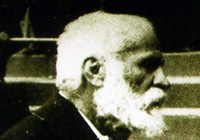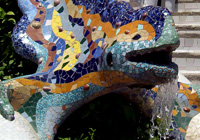Want to learn Spanish surrounded by Gaudí's funky shapes and buildings? With Enforex, you're in luck!
Our Barcelona Spanish school enjoys a prime location in the Eixample district, where Modernista buildings flank the wide boulevards and the spires of the Sagrada Familia soar into the air. Sign up for any of our diverse Spanish courses and Gaudí's incredible creations can be part of your daily walk to school!
Read on for all sorts of information about the life, influences, style and works of Gaudí, and we hope to see you soon here in Barcelona!
Antonio Gaudi: Life Story
One of the singular most famous architects of the 19th and 20th century, Antonio Gaudi has become an international superstar whose work continues to inspire audiences throughout the world and whose name evades noone. Today, no Barcelona guidebook would be complete without a Gaudi creation blessing its cover and our whole perception of modern architecture would be different had this creative legend not left his mark around the streets of Barcelona. So how did the infamous Antonio Gaudi spend his youth?
Born in the province of Tarragona, southern Catalunya, in 1852, Antoni Gaudi i Cornet was the youngest of five siblings. His pensive and observant nature is said to have come from suffering from rheumatism as a child, meaning he could not run around with the same freedom as the other children.
This did not, however, impede him from following his dream and in 1873 he entered into the Escola Tècnica Superior d'Arquitectura in Barcelona, where he studied until the age of 25. During this time he complemented his studies by helping out local architects and gaining experience.


Antonio Gaudi began to receive commissions as soon as he was out of school. He started with smaller projects, like designing lampposts for the Plaça Reial in Barcelona, but this was enough to raise his profile into the limelight.
After his first few years, Gaudi began to come into his own as he broke away from architectural norms and classical styles. He spent until the end of the 19th century producing building after building, each time his sense of direction becoming more prominent. By the beginning of the 20th century Antonio Gaudi was producing the pieces of work that have made him so famous today, his productivity levels were high and his style more unique. However, he did not always receive the popular vote of confidence that he does today - at the time when he was creating and producing he was criticised for his outgoing and daring constructions far more than he was complemented. Fortunately, the few people he did have on his side were wealthy and willing to invest in funding the man they knew would become every architect's hero.
Antonio Gaudi started work on his most famous building, the Sagrada Familia, in 1884 and he continued to work on it throughout his life, dedicating his final years to perfecting it. It was at this monumental landmark in 1926 when Gaudi he was hit by a tram and died, aged 74.
Between 1984 and 2005 seven of Antonio Gaudi's most important works were given UNESCO World Heritage status to ensure their protection.
Antonio Gaudi: Architectural Style
Most closely associated with the Modernist movement, Antonio Gaudi set the standard for all those who were to follow in his footsteps, and he set it high.
However, the elements that characterise his most famous works emerged after years of observation, trial and error. Gaudi's first years out of architecture school saw him spend some time playing around with forms that already existed, in particular, the gothic trend for spires, pointed arches and columns. The work of Eugène Viollet-le-duc was of particular interest to Gaudi. This famous nineteenth century French architect mainly focussed on the restoration of old cathedrals and castles, with a keen focus on the structure of the building and a strong gothic style.
As Antonio Gaudi began to work on the Sagrada Familia in 1884 his work began to come in to its own and the seeds of his distinctive style were sown. However, it was not until the start of the twentieth century that Gaudi entered into his most productive period and sealed his reputation as one of the most innovative architects of all time. Ofcourse, as with many truly famous people, he was not fully appreciated until after his death. During his lifetime he was subject to a lot of criticism for his unusual ideas and styles.
Gaudi's architectural approach tends to begin with organic, biomorphic forms from which it spirals out into an artistic collage of thoughts, feelings and moods. Much of his work uses soft, fluid formations rather than harsh, solid lines, for example, Casa Milá ("La Pedrera"), whose exterior mimics the flowing waves of the sea. The terraced roof of the building offers a truly characteristic vista into the Gaudiesque with its irregular chimneys standing tall like soldiers, covered with multicoloured broken tiles.
Casa Batlló is another of Antonio Gaudi's most iconic creations and is a truly fantastical building set to capture the imagination of anyone who sets eyes on it. Faced with the task of simply restoring the façade of this old house, Gaudi let his creative flair run wild and produced a perfect representation of his artistic vision. And this is what Gaudi was all about. Pushing the boundaries of what it was possible to achieve as an architect and creating buildings that are unique. Since finishing the multicoloured façade of Casa Batlló, with shining chunks of glass adorning its walls and its scaled roof like the immense spine of a dragon, nothing has even come close to capturing this level of fantasy within a functional building. Casa Batlló is more like something you would find in Disneyland than on a normal Barcelona street. And yet there it stands, brightening the days of passersby and inspiring all who see it. A bit of fun amidst the haze of an urban metropolis.
Antonio Gaudi: Famous Works
- Lampposts for the Plaça Reial, Barcelona, Spain (1878)
- Casa Vicens, Barcelona, Spain (1878-1880 UNESCO World Heritage site since 2005)
- Work on the Sagrada Familia, Barcelona, Spain (1884-1926 Nativity Façade and Crypt UNESCO World Heritage site since 2005)
- Palau Güell, Barcelona, Spain (1885-1889 UNESCO World Heritage site since 1984)
- Crypt of Colonia Güell, Santa Coloma de Cervelló, Catalunya (1898-1916 UNESCO World Heritage site since 2005)
- Casa Calve, Barcelona, Spain (1899-1904)
- Parc Güell, Barcelona, Spain (1900-1914 UNESCO World Heritage site since 1984)
- Casa Batlló, Barcelona, Spain (1905-1907 UNESCO World Heritage site since 2005)
- Casa Mila, Barcelona, Spain (1905-1907 UNESCO World Heritage site since 2005)


